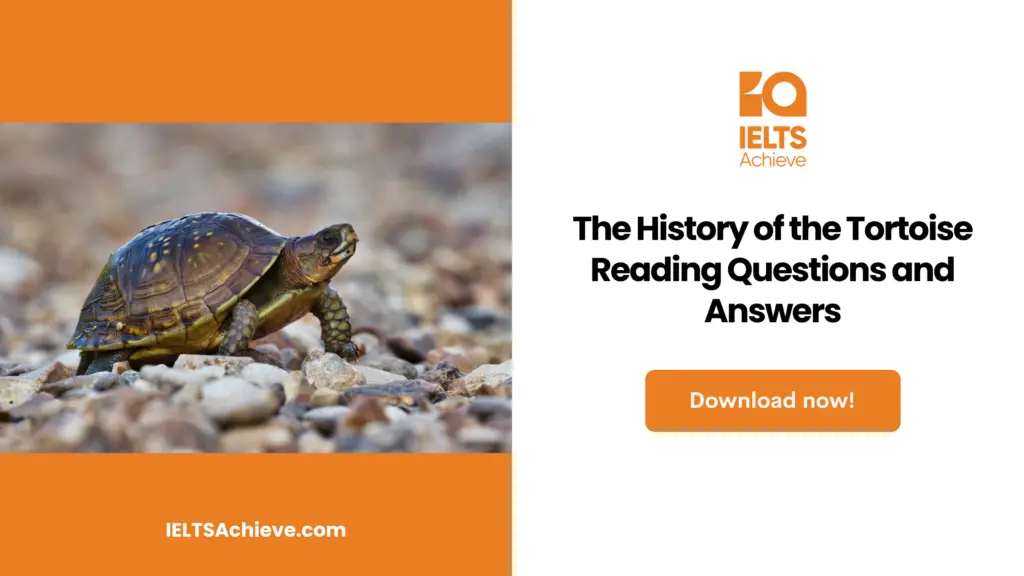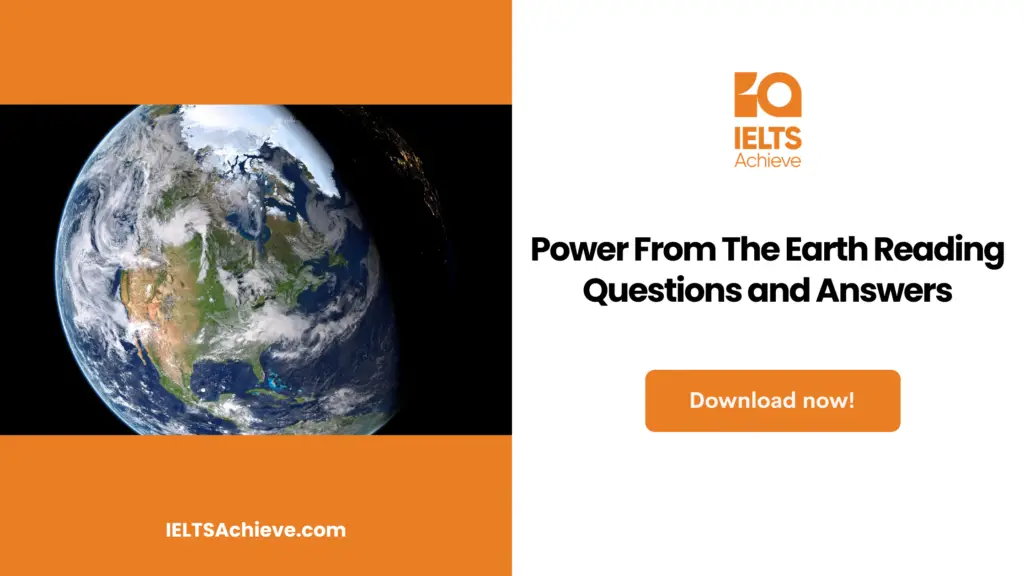The Blog post contains the following IELTS Reading Questions:
- IELTS reading true/false/not given
- IELTS reading short answer questions
- IELTS reading multiple choice questions
Stay informed and prepared for success – Explore our comprehensive Reading Test Info page to get valuable insights, exam format details, and expert tips for mastering the IELTS Reading section.
IELTS reading passage – The history of the tortoise

The History of the Tortoise
If you go far back, everything lives in the ocean. At different topics in evolutionary history, interested individuals from different animal groups traveled to land, sometimes taking their own seawater in blood and cellular fluids, even to the aridest deserts. In addition to the reptiles, birds, mammals, and insects that surround us, other groups that have conquered the water contain scorpions, snails, and crustaceans such as woodlice, land crabs, millipedes and centipedes, spiders, and different worms. We must not forget the vegetation, without whose pre-invaded land, no other migrations could have taken place.
Going from water to land involves a significant reshaping of every part of life, and involves respiration and reproduction. However, a good number of terrestrial animals later returned, abandoning the hard-earned terrain resurfacing tool and returning to the water. The seals were only partially returned. On the way to extreme events like Whales and dugongs, they display to us what mediators would have been like. Whales and dugongs, their closest relatives, the Manatees, ceased to be terrestrial creatures as a whole and returned to the whole marine customs of distant ancestors. They do not even come ashore to breed. Nevertheless, they still breathe air, creating nothing similar to the gills of their previous marine incarnation. Turtles went to sea a long time ago, and like all vertebrates that return to the water, they breathe air. Yet, they are, in a way, less likely to return to the water than whales or dugongs because turtles still lay their eggs on the beaches.
There is proof that all modern turtles are descended from a terrestrial ancestor who lived before most dinosaurs. From the earliest dinosaur times, there are two major fossils known as Proganochelys quenstedti and Palaeochersis talampayensis, all of which are closely related to the ancestry of modern turtles and tortoises. You may be wondering how we can tell if fossil animals lived on land or in water, particularly when only fragments are discovered. Sometimes it’s clear. Ichthyosaurs are reptile contemporaries of dinosaurs, with paddles and streamlined bodies. The fossils look like dolphins and they certainly lived in the water like dolphins. With turtles, it manifests a little less. One method is to measure the bones of their forearms.
Walter Joyce and Jacques Gauthier of Yale University obtained three measurements on the specific bones of 71 species of living turtles and turtles. They used a type of triangular graph paper to plan all three measurements against each other. All terrestrial turtle species formed a tight spot at the top of the triangle, while all water turtles are at the bottom of the triangular graph. They are not mutually exclusive, except to add some species that spend time in water and land. Of course, this amphibious species appears on the triangular graph almost halfway between the ‘wet cluster’ of sea turtles and the ‘dry cluster’ of land turtles. Determining where the fossils fell was the next step. We have no doubt the bones of P quenstedti and JR talampayensis. Their points on the graph are the thickness of the dry mass. Both of these fossils are arid land turtles. They came before our turtles could return to the water.
So, as most mammals did after going to sea, you might guess that modern land turtles may have stayed on land since that early terrestrial period. But obviously not. If you draw the family tree of all current turtles and tortoises, almost all the branches are aquatic. Today’s land turtles are a branch with deep nests built among the branches of aquatic turtles. This suggests that modern land turtles have not relied on the land continuously since the time of P. quenstedti and P. talampayensis. On the contrary, their ancestors were among those who returned to the water, and they reappeared on land in recent times.
Therefore, turtles represent significant double returns. As with all mammals, reptiles, and birds in general, their distant ancestors were marine fish, before which various more or less worm-like creatures, still in the sea, developed into primary bacteria. Later ancestors lived on the land and stayed there for many ages. Afterward, ancestors still turned into water and became sea turtles. Eventually, they returned to the land as turtles, some of which now live in arid deserts.
Unlock your full potential in the IELTS Reading section – Visit our IELTS Reading Practice Question Answer page now!
Recommended Questions:
Renewable Energy IELTS Reading Question with Answer
The history of the tortoise IELTS reading questions
Question (1-4)
Do the following statements agree with the information given in the reading passage?
Write
TRUE – if the statement agrees with the information
FALSE – if the statement contradicts the information
NOT GIVEN – if there is no information on this in the passage
1. Without whose pre-occupied land, no other displacements could have taken place.
2. Turtles never went to sea for a long time, like all vertebrates.
3. Turtles still lay their eggs on the beaches.
4. Turtles are among the first batch of creatures to return to the sea.
Enhance your skills in identifying information as True, False, or Not Given. Click here to discover expert strategies and techniques for mastering this question type in the IELTS Reading section.
Question (5-9)
Answer the questions below.
Choose NO MORE THAN THREE WORDS from the passage for each answer.
5. Who lived before most dinosaurs?
6. Who are the Proganochelys quenstedti and Palaeochersis talampayensis?
7. What does the fossil look like?
8. Walter Joyce and Jacques Gauthier are from?
9. Which species appear on the triangular graph?
Question (10 – 12)
Choose the correct letter, A – D
10. All current turtles and tortoises, almost all the branches are
A. ancestors
B. fossils
C. aquatic
D. terrestrial
11. Modern land turtles have not relied on the
A. water
B. desert
C. sea
D. land
12. Later ancestors still turned into water and became
A. land turtles
B. sea turtles
C. arid sea turtles
D. arid land turtles
Ready to improve your performance in Multiple Choice Questions (MCQs)? Click here to access our comprehensive guide on how to tackle MCQs effectively in the IELTS Reading section.
Unlock your full potential in the IELTS Reading section – Visit our IELTS Reading Practice Question Answer page now!
Recommended Questions:
Renewable Energy IELTS Reading Question with Answer
The history of the tortoise IELTS reading answers
1. True
2. False
3. True
4. Not given
5. terrestrial ancestor
6. fossils
7. dolphins
8. Yale University
9. amphibious
10. C. aquatic
11. D. land
12. B. sea turtles

We hope you found this post useful in helping you to study for the IELTS Test. If you have any questions please let us know in the comments below or on the Facebook page.
The best way to keep up to date with posts like this is to like us on Facebook, then follow us on Instagram and Pinterest. If you need help preparing for the IELTS Test, join the IELTS Achieve Academy and see how we can assist you to achieve your desired band score. We offer an essay correction service, mock exams and online courses.
